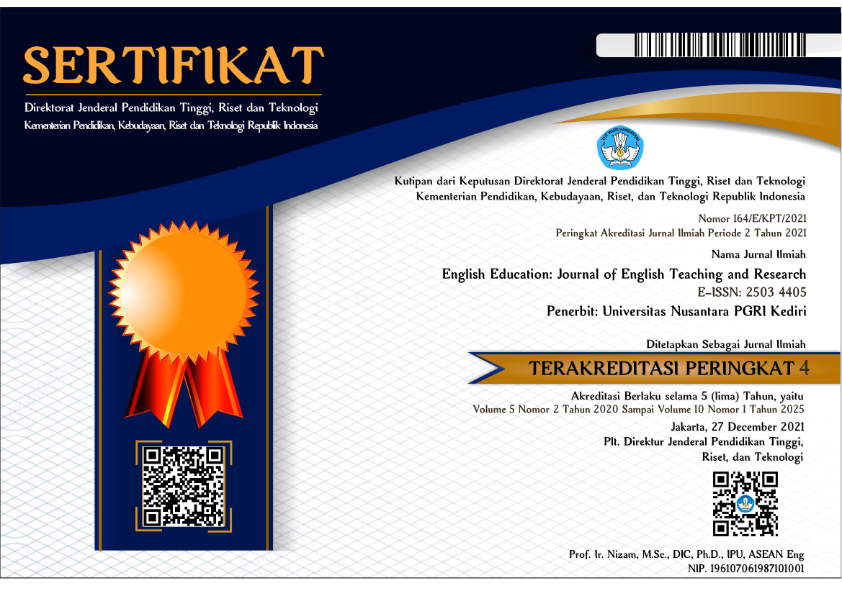MOBILE-ASSISTED ON EXTENSIVE READING: STUDENTS’ VOICES
DOI:
https://doi.org/10.29407/jetar.v5i1.14367Keywords:
digital reading, extensive reading, students’ perceptionAbstract
Abstract
As reading starts to lose its popularity for most students, digital reading can serve as a solution to overcome this problem. The integration of digital reading and extensive reading practice can be beneficial for language learners. A number of researchers have conducted the studies on this issue through different perspectives. The current study mainly focuses on the students’ perception of digital reading in extensive reading practice. The qualitative approach was employed to obtain the research data. Therefore, series of questions were addressed to achieve the research objective through an open-ended interview. The result showed that the students have positive attitudes towards digital reading when they have to read extensively. The practicality, portability, flexibility, accessability, and affordances of e-books helped them to apply extensive reading successfully. Moreover, extensive reading benefits the students to develop their reading habit, discover pleasure in reading, as well as improve other skills in English.
Keywords: digital reading, extensive reading, students’ perception
Downloads
References
Anderson, R. C., Wilson, P. T. & Fielding, I.G. (1988). Growth in reading and how children spend their time outside of school. Reading Research Quarterly, 23(3): 285-303.
Beglar, D., & Hunt, A. (2014). Pleasure reading and reading rate gains. Reading in a Foreign Language, 26 (01): 29-48.
Cho, K., & Krashen, S. (1994). Acquisition of Vocabulary from the Sweet Valley Kids Series: Adult ESL Acquisition. Journal of Reading, 37(8): 662–667.
Retrieved from https://pdfs.semanticscholar.org/513b/a2ea81ba48b8cbcd48265269897e4bc3ed7b.pdf
Creswell, J. W., & Poth, C. N. (2018). Qualitative inquiry & research design: Choosing among five approaches (Fourth edition). Los Angeles: SAGE.
Day, R., & Bamford, J. (1998). Extensive reading in the second language classroom. New York: Cambridge University Press.
Facer, K., Joiner, R., Stanton, D., Reid, J., Hull, R., & Kirk, D. (2004). Savannah: mobile gaming and learning? Journal of Computer Assisted Learning, 20(6), 399-409. https://doi.org/10.1111/j.1365-2729.2004.00105.x
Huang, H. (2013). E-reading and E-discussion: EFL learners’ perceptions of an
E-book reading program. Computer Assisted Language Learning, 26(3): 258–281.
Krashen, S. (2004). The power of reading: Insights from the research. Westport, Conn: Libraries Unlimited. Retrieved from https://www.scribd.com/doc/232812845/Stephen-D-Krashen-the-Power-of-Reading-Insight.
Lin, C. C. (2014). Learning english reading in a mobile-assisted extensive
reading program. Computers & Education: An International Journal. 48-59.
Mesureur, G. (2013). An evaluation of ESL reading efficiency and motivation using E-book vs. printed book. In S. Miles & M. Brierley (Eds.), Extensive Reading World Congress Proceedings (pp. 280-290). Seoul: Extensive Reading Foundation.
Mikulecky, B. S. (2008). Teaching reading in a second language. London: Pearson Education, Inc.
Milliner, B. & Cote, T. (2015). Mobile-based extensive reading: an investigation into reluctant readers. International Journal of Computer-Assisted Language Learning and Teaching. 5(4): 1-15. https://doi.org/10.4018/IJCALLT.2015100101
Robb, T., & Kano, M. (2013). Effective extensive reading outside the classroom: A large-scale experiment. Reading in a Foreign Language, 25(2): 234–247.
Safaeia, L.A. &Bulca, M. (2013). Extensive reading and creative practices. Procedia - Social and Behavioral Sciences. 70(2013): 592 – 597.https://doi.org/10.1016/j.sbspro.2013.01.097
Stanley, G. (2005). Extensive Reading. Retrieved from https://www.teachingenglish.org.uk/article/extensive-reading.
Downloads
Published
Issue
Section
License
Authors who publish with this journal agree to the following terms:
- Copyright on any article is retained by the author(s).
- The author grants the journal, the right of first publication with the work simultaneously licensed under a Creative Commons Attribution License that allows others to share the work with an acknowledgment of the work’s authorship and initial publication in this journal.
- Authors are able to enter into separate, additional contractual arrangements for the non-exclusive distribution of the journal’s published version of the work (e.g., post it to an institutional repository or publish it in a book), with an acknowledgment of its initial publication in this journal.
- Authors are permitted and encouraged to post their work online (e.g., in institutional repositories or on their website) prior to and during the submission process, as it can lead to productive exchanges, as well as earlier and greater citation of published work.
- The article and any associated published material is distributed under the Creative Commons Attribution-ShareAlike 4.0 International License








 Article template
Article template



